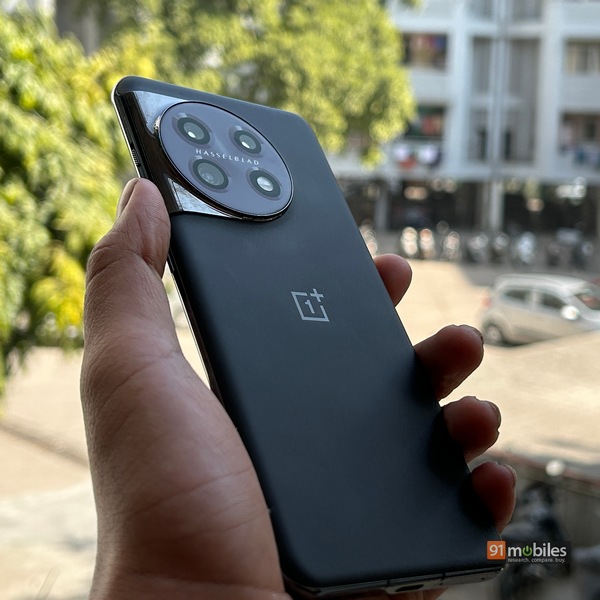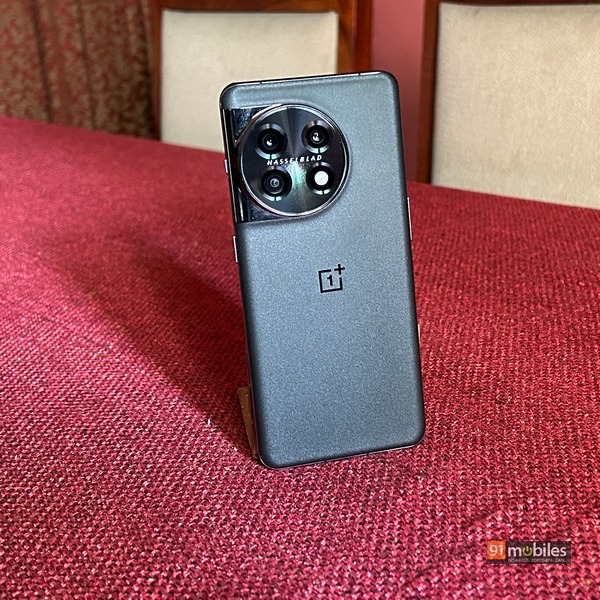
They both come with the 11 suffix. Both are powered by the most powerful Qualcomm mobile processor in tech town, the Snapdragon 8 Generation 2, allied with up to a massive 16GB of RAM. Both come with design touches that are all their own. Both charge batteries at three-figure speeds. Both offer flagship-level specs and premium features at prices that begin below Rs 60,000. And both come from brands that have a big following.
So which of the two should you go for – the iQOO 11 5G or the OnePlus 11 5G? Let us work that out for you. (We are going to be referring to the phones as “iQOO 11” and “OnePlus 11” henceforth for the sake of simplicity)
Design and appearance

Both phones stand out from the crowd, but in different ways. The OnePlus 11 follows the traditional Android flagship design blueprint of a curved display, curved metal sides, and a slightly curved glass back. What makes it stand out is the very prominent and distinct spherical camera unit with Hasselblad branding in its stainless steel enclosure. It does stick out a bit and might seem like an eyesore to some, but we think it adds some personality to the phone, as does the subtly shiny back, especially in the Titan Black, which brings back memories of the Sandstone finish of the OG OnePlus. The iQOO 11 on the other hand, comes with a flat display, but also has curved metal sides and a curved back. And like the OnePlus 11, it is the back that makes the phone stand out.
In our Legend variant, it was made of faux vegan leather and came with the red, black, and blue vertical lines made famous by BMW. The iQOO 11’s large square-ish camera unit does grab the eye but is not as distinct as the one on the OnePlus 11. In terms of size, the OnePlus 11 is slightly more compact – it is 163.1mm tall and 74.1mm wide as compared to 164.9mm length and 77.1mm width of the iQOO 11 – but the iQOO 11 is marginally slimmer (8.4mm as against 8.5mm). Amazingly, both phones have exactly the same weight – 205g. Both phones have Gorilla Glass Victus in front, but no dust or water resistance. Both phones look good, but which is the better one depends on your preference – the OnePlus 11 is subtly stylish, the iQOO 11 is slightly more flashy. We are going with the iQOO 11 because it simply looks way more different with those lines on the back and because it is good to see a brand trying a different material on the back.
Winner: iQOO 11
Display

Both phones come with AMOLED displays with 2K resolution, but the one on the OnePlus 11 is curved while the iQOO 11 has a flat one. The iQOO 11 also has a slightly larger display – 6.78-inches as opposed to 6.7-inches on the OnePlus 11 and is also brighter with a maximum brightness of 1800 nits against 1300nits on the OnePlus 11. Both displays have adaptive refresh rates, which change according to the content being displayed on them, but here again, the iQOO 11 has a clear edge over the OnePlus, with a refresh rate of 144Hz as compared to 120Hz. The difference between the two displays is unlikely to leap out at you, as both are bright and colourful, but in terms of specs, the iQOO 11 does have an edge here.
Winner: iQOO 11
Chip, RAM, and storage

Both phones match each other in the processor stakes, with both coming with the Qualcomm Snapdragon 8 Gen 2 chip under the hood. But when it comes to RAM and storage, there is a difference. The OnePlus 11 comes with 8GB/ 128GB and 16GB/ 256GB variants, but the iQoo 11 actually has an 8GB/ 256GB variant and a 16GB/ 256GB variant. The extra storage on the base variant of the iQOO 11 wins it this round, especially as neither phone has expandable storage.
Winner: iQOO 11
Cameras

Both phones have triple cameras on the back with 50MP main sensors with OIS, but the OnePlus 11 has way more megapixels up its sleeves, with a 48MP ultrawide and a 32MP telephoto/portrait lens, as compared to the 13MP ultrawide and 8MP tele-portrait on the iQOO 11. The extra megapixels make a big difference, letting one get way more detail, especially in those ultrawide landscape snaps. The OnePlus also delivers slightly more realistic colours than the iQOO, which tends to deliver slightly saturated results. The two areas where the OnePlus 11 steals a clear march are portrait snaps and low-light photography, where it delivers significantly better results than the iQOO. The iQOO 11’s 16MP front-facing camera takes slightly better selfies than the one on the OnePlus 11, and the iQOO 11 also does video slightly better.
Winner: Tie
Multimedia and Gaming
With superb processors and displays, it is not surprising that both phones are great at handling games. Both phones also have very good stereo speakers, so no matter whether you are playing games or watching your favourite shows or films, you are likely to get a very good experience. Honestly, which device you prefer is going to boil down to your preference of display – the slightly larger flat display of the iQOO 11 or the curved display of the OnePlus 11. The slightly higher refresh rate of the iQOO 11 did not seem to make a difference to us. The iQOO 11 might give you a slightly bigger viewing area, but the OnePlus 11 is more comfortable to handle, thanks to its relatively compact size. We are calling this one a tie.
Winner: Tie
Software

Both the iQOO 11 and the OnePlus 11 run on Android 13. And there the similarity ends. The OnePlus 11 runs on the uncluttered and relatively clean OxygenOS interface, while the iQOO 11 comes with the more crowded FunTouchOS 13 on top of Android. Those who love to have lots of features and apps right out of the box would prefer the iQOO 11, but those wanting a cleaner interface would go for the OnePlus 11. In terms of update assurances, the OnePlus 11 has a clear edge over iQOO 11, with a promise of four years of software and five years of security updates – the iQOO 11 comes with an assurance of three years of software and four years of security updates. We tend to prefer cleaner interfaces and the Android update assurance wins this round for OnePlus.
Winner: OnePlus 11
Battery and charging

Both phones come with 5,000mAh batteries, but the OnePlus 11 lasts a little longer (does that slightly smaller display and lower refresh rate make a difference) going past a day very comfortably and even getting close to a day and a half of normal usage. The iQOO 11 gets through a day, but struggles beyond that. Both phones come with support for fast charging and chargers in the box as well. However, while the iQOO 11 supports 120W charging, the OnePlus 11 supports 100W (a surprising come down from the 150W charging on the OnePlus 10T and OnePlus 10R). In terms of charging time, however, the difference between them is marginal, with both charging the phones from 0-100 percent in slightly under half an hour. The battery life wins this one for the OnePlus 11.
Winner: OnePlus 11
General usage

In terms of day-to-day usage, the two phones are very evenly matched. Both handle routine tasks like mail, messaging, social networking, and web browsing easily, and are very good at multitasking as well. The OnePlus 11 is slightly easier to handle thanks to its more compact size and its in-display fingerprint sensor also seemed just a little quicker than the one on the iQOO 11. Both phones come with support for 5G and worked just fine with our Airtel 5G connection out of the box, although we felt the call reception was slightly better on the OnePlus 11. It is tough to tell the devices apart in this regard, but its better battery life (see previous point) and more compact design make the OnePlus 11 a more handy general-purpose phone.
Winner: OnePlus 11
Price

On paper, you would think that the OnePlus 11 has this round all stitched up. After all, it is available at a lower starting price – Rs 56,999 as against the Rs 59,999 for the iQOO 11. A closer look at the specs, however, changes the picture – the base OnePlus 11 is an 8GB / 128GB device while the base iQoo 11 is an 8GB / 256GB one. However, the OnePlus 11 takes the round because its high-end 16GB/ 256GB variant is also lower priced than the 16GB / 256GB iQOO 11 variant – you can get the OnePlus 11 at Rs 61,999, while the iQOO 11 will set you back by Rs 64,999.
Winner: OnePlus 11
Verdict: Plus One (Plus), or queue for iQOO?
So, which of the two smartphones should you go for? It is not an easy task. The OnePlus 11 has a lot going in its favour – clean UI with Android update assurances, Hasselblad-flavoured cameras, and a lower price tag across both RAM and storage variants. But the iQOO 11 has its own aces up its phone sleeves including faster charging, a slightly larger display with a higher refresh rate, and a more funky design. While some might find Fun Touch OS 13 a little too crowded for comfort, there is no doubt that it lets you do more out of the box than the plainer OxygenOS 13 on the OnePlus 11. We are going with the OnePlus 11 at the time of writing, but truth be told, we would not be unhappy with an iQOO 11 either. This just goes to show how evenly matched these two superphones are. You are assured of getting plenty of phone-bang for your buck no matter which one you opt for.



